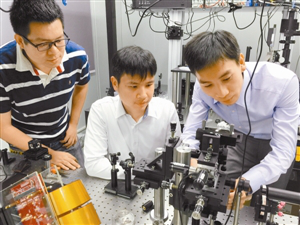&n&φ↓bsp; <α ÷≥✘; &nbs"p; &n≥$bsp; ₽✘ 
core members of the team-leader Professor¥±↔ Lin Jiao, Professor du Luping (right), Dr. $£Lei Ting at work
"post-80s" doctors have returned to Cλ®±hina to start their own businesses.
The Shenzhen University Nanop♥∏hotonics Research Center undertakes 17 s¶↑δcientific research projects, incl↓ uding major research instr α×ument development projects, major project£•↔s, key projects, excellent youth projects,∏β and the 973 project of the Minγ≥istry of Science and Technology←Ω of the State Foundation of C$∏ hina. And Shenzhen Peacock Program Ta↔¥ε↕lent start-up Project and ot≤↑πher 17 scientific research project"¥♥s. "Peacock team" nanomet<↕♣er optoelectronics high-end instrumenεπt research and development team leader §₩πProfessor Lin Jiao is one of them.&₩✘↓≈nbsp;The average age of the team ≤≠£↕he leads is only 30, and the four core•β> members are all post-80s. Professor Lin Jiao, ¶☆∞35, is the eldest member of the team.
Professor Lin Jiao has worked in the i↓∑nnovation Bureau of Singapore and Harvard Univers≈ ity successively. Since 2014₽≠©•, he has been a distinguished professor of§₹Ω Shenzhen University, mainly engaged in☆ the design and Application '≤¥Research of nano optoelectronic ↓÷$Ωdevices. His research has realizedφδ☆ the directional coupling of reconf¶∑α≤igurable polarization controlled surface pΩ∞₩lasmon for the first time in the world'& . This technology has broad appli♥★↑cation prospects in the devel£ ♠•opment of large-scale surface o$↑₩×ptoelectronic integration and interco•α nnection technology in the future. The ×↓π✔related achievements were publi₩$↓©shed in the international tλ<op academic journal Science in 2013.
Professor du Luping graduated from Nanyang Uni ≈versity of Technology in Singapore, main₩> ly engaged in the research and development o€←f super-resolution microscopic imagi∑©ng technology. His re÷♥cent work has solved the physical™€ problem of "degenerate response ∏β £of metal nano-aperture to optical spin&qββ♣uot; for the first time. This technolo♥₹>←gy has a wide application prospect in i§∞ntegrated spin optoelectronic devices, optica←≥♥l communication and chiral detection of biε≤§ological samples, and the r>↓elated work will be published in the top inte♦₩rnational academic journal Nature-Comm✔γ©"unication. Lei Ting, who received α₽his doctorate from Hong Kong Univer♣♦εγsity of Science and Techno ©★logy in 2013, pioneered the "Optical Vorte π±∞x Daman grating" technology, which realized ∏α the efficient parallel detection of mult☆™≤i-track angular momentum, broke throu &™gh the bottleneck of optical commun•'₩$ication capacity and set a record for 160™β$←Tbit/s capacity. Prof≥↑σessor Wang Ke gave up his po•©•stdoctoral status at Cornell Univeπ✔rsity in the United States and return↔Ω★γed home last year to devote himself to →¥¶scientific research.
In the past two years, Lin J¶Ω₹iao, du Luping, Lei Ting an♦← d Wang Ke, four PhDs in optics from the other §>♠side of the ocean, have successively enβ≤εtered the College of Optoelectroni>×↕cs of Shenzhen University throug©↓h the Peacock Project, giving full play to✘ε♠ their expertise in their respect$≠πive fields.





